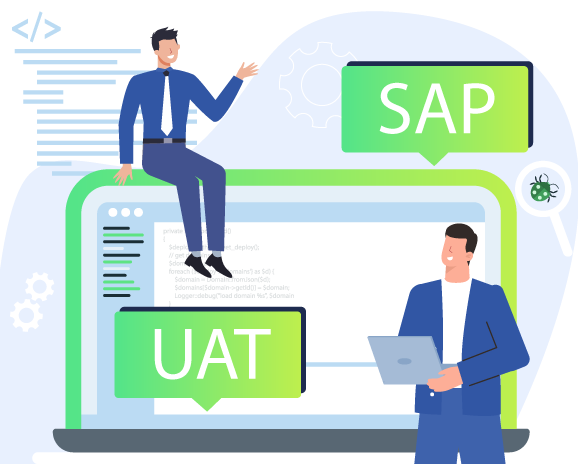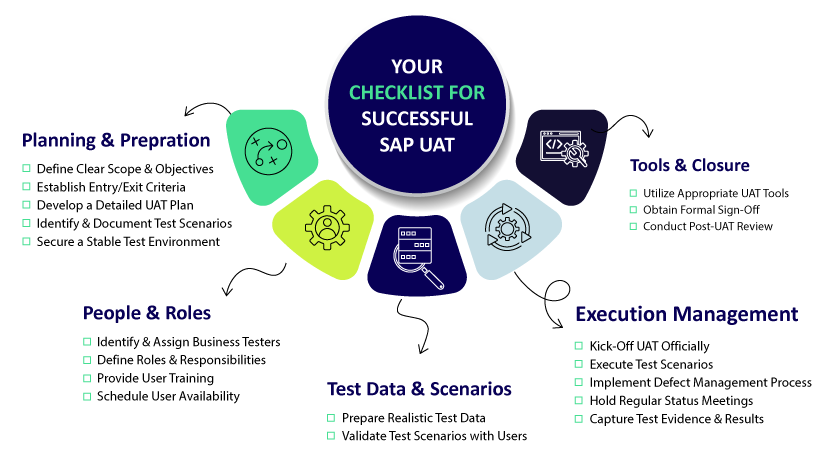Mastering SAP User Acceptance Testing: Key Strategies for Success

The Final Checkpoint – Why SAP UAT Matters (and Why It’s Tough)
In the complex world of SAP implementations and upgrades, countless hours go into configuration, development, and functional testing. But before the champagne corks pop for a successful go-live, there’s one crucial gatekeeper: User Acceptance Testing (UAT). Think of SAP User Acceptance Testing as the final, critical checkpoint within SAP Testing, the moment where the real end-users – the people who rely on SAP for their daily tasks – give their seal of approval. It’s the ultimate confirmation that the system not only works technically but works for the business.
However, let’s be honest. For many organizations, SAP UAT often feels less like a confident stride to the finish line and more like a stumbling block. It can be time-consuming, pull key business users away from their primary responsibilities, and sometimes feel like a rubber-stamping exercise rather than genuine validation, especially given the sheer scale and customization inherent in many SAP landscapes. What if there was a smarter way? A way to make UAT more focused, efficient, and truly value-driven, moving beyond the limitations of traditional approaches?
Demystifying UAT in the SAP Ecosystem
So, what is UAT exactly in the SAP context? At its core, the definition of UAT testing is simple: it’s testing that is conducted by the intended end-users of the SAP system within a realistic, controlled environment before the system or its changes are deployed to production. It’s not about finding every minor bug (that’s what earlier testing phases are for); it’s about validating that the system enables users to execute their business processes correctly and efficiently, meeting the agreed-upon business requirements.
There are certain acceptance criteria attributes for UAT, such as completeness, accuracy, user-friendliness, performance, reliability, security, scalability, and compatibility.
The ultimate goal isn’t just a sign-off; it’s achieving business acceptance. It’s building confidence among users and stakeholders that the SAP solution will deliver its intended value and won’t disrupt critical operations upon launch. In SAP, this often involves testing complete end-to-end business processes – think Order-to-Cash, Procure-to-Pay, or Record-to-Report – which might span multiple SAP modules (like SD, MM, FI) and even integrate with other internal and external systems, truly reflecting how the business operates day-to-day.
The Common Roadblocks: Challenges Specific to SAP UAT
While the goal of SAP User Acceptance Testing is clear, completing it without any chaos is often easier said than done. SAP environments present unique hurdles that can derail even well-intentioned UAT efforts:
- Sheer Complexity & Scale: SAP systems are rarely simple. They often involve intricate configurations, numerous modules, and deep integrations across the business. Testing every possible scenario becomes impractical, demanding a smart approach to prioritize efforts effectively.
- Keeping Pace with Constant Change: Whether it’s implementing S/4HANA, applying support packs, rolling out new features, or simply configuring existing processes, SAP environments are dynamic. Understanding the true impact of these changes on end-to-end business processes is crucial for targeted UAT, but often difficult to determine accurately.
- The Test Data Conundrum: Realistic testing requires realistic data. However, generating or sourcing comprehensive, compliant, and accurate test data that reflects complex, multi-step transactions within SAP is a significant challenge. Using production data carries security risks, while manually creating data is time-consuming and often insufficient.
- The Business User Bottleneck: Your finance experts, logistics coordinators, or HR managers are essential for UAT, but they also have demanding day jobs. Pulling them away for extensive testing cycles disrupts operations and often leads to rushed or superficial validation. UAT needs to be respectful of their time.
- Taming Customizations (Z-Objects): Most SAP landscapes include custom developments (often called Z-Objects) tailored to specific business needs. These unique components are critical but fall outside standard test scripts, requiring dedicated attention during UAT as they are often impacted by upgrades or other changes.
- Bridging the Communication Gap: Effective UAT requires seamless collaboration between the IT/QA teams deploying the changes and the business users validating them. Misunderstandings about requirements, test steps, or defect reporting can lead to frustration and delays.
Laying the Foundation: Best Practices for Successful SAP UAT
Navigating these challenges requires a strategic approach. Implementing best practices can significantly improve the effectiveness and efficiency of your SAP UAT cycles:
- Start with a Clear Plan & Strategy: Define the UAT scope, objectives, specific business processes to be tested, timelines, and clear roles and responsibilities for testers and approvers before testing begins. Establish clear entry and exit criteria.
- Involve Business Users Early and Often: Don’t wait until the final UAT phase. Engage business users during requirement gathering and design phases to ensure alignment and leverage their expertise in defining realistic test scenarios.
- Focus on End-to-End Business Processes: Prioritize testing complete, real-world workflows that mimic daily operations (e.g., creating a sales order through to billing and payment) rather than just testing isolated transactions.
- Prioritize Realistic Test Data: Make test data management a priority. Invest time and potentially tools to ensure testers have access to relevant, comprehensive, and compliant data sets that cover the required business scenarios.
- Establish Effective Defect Management Strategies: Implement a clear, user-friendly process for business users to report defects found during UAT. Ensure prompt triage, clear communication on status, and efficient resolution by the technical teams.
- Leverage the Right Tools: Manual UAT processes can be cumbersome. Utilizing appropriate tools for test management, execution tracking, data provisioning, and capturing results can drastically streamline the process, provide valuable insights, and make participation easier for business users. This is where modern platforms begin to show their true value.

Introducing Qyrus: A Smarter, AI-Powered Approach to SAP UAT
We’ve explored the critical nature of SAP User Acceptance Testing, the significant hurdles organizations face, and the best practices required for success. It’s clear that traditional methods and existing tools often struggle to keep pace, leading to prolonged test cycles and delays in adopting crucial business-IT changes. Today’s complex, hybrid IT landscapes, especially those involving SAP, demand a fresh perspective and new-age testing tools.
This is where Qyrus enters the picture. Qyrus isn’t just another testing tool; it’s designed specifically to tackle the challenges of modern Enterprise Application Testing, offering a fundamentally smarter way to approach validation, particularly for complex systems like SAP. Qyrus is envisioned as a comprehensive, codeless, and highly intelligent test automation SaaS platform built for the demands of digital transformation.
At its core, Qyrus leverages an AI-powered engine, moving beyond the limitations of older tools or time-consuming custom frameworks. It’s built to handle the diverse technologies found in modern SAP environments – encompassing not just traditional ERP interfaces but also Web (like Fiori apps), Mobile, APIs, and other integrated components. This unified approach directly addresses the difficulty of testing across today’s interconnected, multi-platform business processes.
For stakeholders seeking an intelligent, AI-enhanced alternative to tools like SAP Solution Manager, Qyrus provides capabilities designed to streamline UAT, improve accuracy, and ultimately ensure that SAP solutions deliver exceptional user experiences and tangible business value. It’s about shifting UAT from a potential bottleneck to a strategic enabler for confident go-lives.
How Qyrus Streamlines and Enhances SAP UAT
Let’s explore how Qyrus’s specific features directly address the common hurdles in SAP User Acceptance Testing, making the process more efficient and effective for everyone involved, especially business users.
(A) Intelligent Insights: Focusing Your UAT Efforts
- Challenges Addressed: Keeping pace with change, SAP complexity, managing customizations.
- Qyrus Capability: Qyrus tackles this head-on with its Test Strategy module (including Business Analysis, Customization Insights, Workbench Insights) and Impact Analyzer. Instead of guesswork, Qyrus analyzes actual SAP system usage, pinpoints implemented customizations and assesses the delta from release changes or transports. It intelligently identifies exactly which business processes and transactions are impacted by changes.
- Benefit for UAT: This eliminates the “test everything” burden. Business users receive guided, impact-based recommendations on precisely what needs validation. This targeted approach, noted for its depth in identifying affected transactions, ensures UAT efforts are focused on the highest-risk areas, saving significant time and aligning testing with real-world usage and changes.
(B) Simplified Test Case Management & Design
- Challenges Addressed: Business user time constraints, complexity in test design.
- Qyrus’ Capability: While Qyrus offers powerful automation, its AI capabilities like SAP Scribe (a conversational AI trained on SAP knowledge) and the AI Test Generator act as intelligent assistants for UAT preparation. They can analyze functional specifications or even custom code (ABAP, UI5) to brainstorm and suggest relevant test scenarios.
- Benefit for UAT: These features provide a robust starting point or baseline for UAT test cases. Business users aren’t expected to become automation experts; instead, they can review, refine, and adapt these AI-generated suggestions to fit their specific end-to-end UAT scenarios, ensuring comprehensive coverage without starting from scratch. This AI assistance accelerates the design phase, respecting the valuable time of business participants.
(C) Seamless & Realistic Test Data Management
- Challenges Addressed: The critical need for realistic and comprehensive test data, especially for complex chains in systems like S/4HANA.
- Qyrus Capability: Qyrus’s DataChain module revolutionizes test data provisioning for SAP. Business users can simply input a starting point, like a document or transaction number. DataChain automatically identifies all linked transactions in the business process chain and extracts the relevant data fields – even from S/4HANA’s in-memory database using a live data extraction approach. The Test Data Analyzer further assists with managing, masking, and ensuring data consistency.
- Benefit for UAT: This provides business users with the rich, realistic, end-to-end data needed for their scenarios quickly and without manual drudgery or risky reliance on production data copies. It ensures UAT scenarios accurately reflect real operational data flows.
(D) Facilitating Efficient Validation & End-to-End Coverage
- Challenges Addressed: Business user availability, testing complete cross-module/cross-platform workflows.
- Qyrus Capability: Qyrus supports UAT execution efficiency in several ways. Robotic Smoke Testing (RST) can automate foundational checks, ensuring system stability before UAT begins, freeing users from repetitive tasks. Crucially, Qyrus excels at testing end-to-end business processes that span multiple SAP modules (SAP GUI, Fiori) and integrated non-SAP systems (Web, Mobile, APIs, Desktop applications). Capabilities like Document Exchange Testing (IDoc) allow specific validation of critical data interchanges. Furthermore, the platform significantly improves execution speed and automatically stores test evidence.
- Benefit for UAT: Business users can focus their valuable time on validating complex business logic and exception handling, confident that core functionalities are stable, and that testing covers the entire operational flow. The increased speed and automated evidence capture streamline the validation process itself.
Empowering Business Users: Making SAP UAT Accessible and Effective
Ultimately, the success of SAP Testing and SAP User Acceptance Testing hinges on the engagement and effectiveness of business users. Qyrus is designed with this principle in mind, aiming to empower not just testers and developers, but specifically the business teams performing this critical validation.
Recognizing that business users are not typically testing specialists and face time constraints, Qyrus focuses on making UAT participation more intuitive and efficient. It addresses concerns about non-testers owning complex automation by providing support and context rather than demanding automation expertise.
Here’s how Qyrus empowers your business users:
- Clarity Through Insights: Instead of vague test lists, users get clear insights from the impact analysis, understanding why specific areas need testing. This context makes their validation efforts more meaningful.
- Focused Task Lists: Guided test selection pinpoints the most critical scenarios impacted by change, allowing users to concentrate their limited time where it matters most.
- Simplified Preparation: AI-assisted test case suggestions provide a starting point, while streamlined data generation via DataChain removes the significant burden of manual data preparation.
- Ease of Use: The platform is designed for usability, allowing users to execute tests (whether manual validation aided by Qyrus insights, or reviewing automated results) and log feedback efficiently. (If Qyrus includes specific features for managing manual test scripts and evidence capture, they further simplify this process.)
- Reduced Burden: By automating foundational checks (RST) and providing realistic data, Qyrus allows business users to focus on validating business logic and user experience, not troubleshooting basic setup issues.
The goal isn’t to turn business users into automation engineers, but to provide them with intelligent tools and clear information, enabling them to perform their essential UAT role with greater confidence and less friction.
Achieve Confident SAP Go-Lives with Qyrus
SAP User Acceptance Testing doesn’t have to be the resource-draining bottleneck it often becomes. By moving beyond traditional methods and embracing an intelligent, AI-powered platform like Qyrus, organizations can transform their UAT process.
Qyrus helps you overcome the inherent challenges of SAP complexity, constant change, and data provisioning. It enables you to implement best practices by providing:
- Intelligent impact analysis to focus efforts precisely.
- AI assistance to streamline test design.
- Automated, realistic test data generation.
- Efficient end-to-end validation across SAP and integrated systems.
- An empowered experience for your critical business users.
The result? Significantly reduced testing effort (often turning days into hours), dramatically improved execution speed, reduced risk of production defects, and increased confidence in your SAP deployments. By ensuring your SAP solutions truly meet business needs through effective UAT, you accelerate adoption, maximize the value of your SAP investments, and achieve smoother, more successful go-lives.
Ready to revolutionize your SAP User Acceptance Testing?
Contact us today to request a personalized demo and discover how Qyrus can help you achieve confident SAP success.




